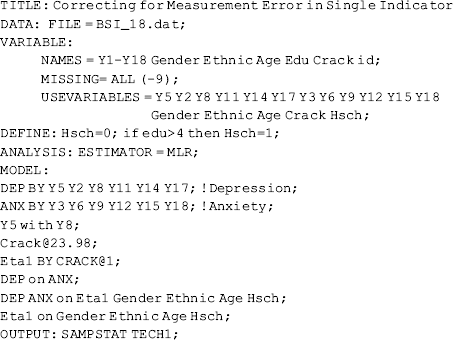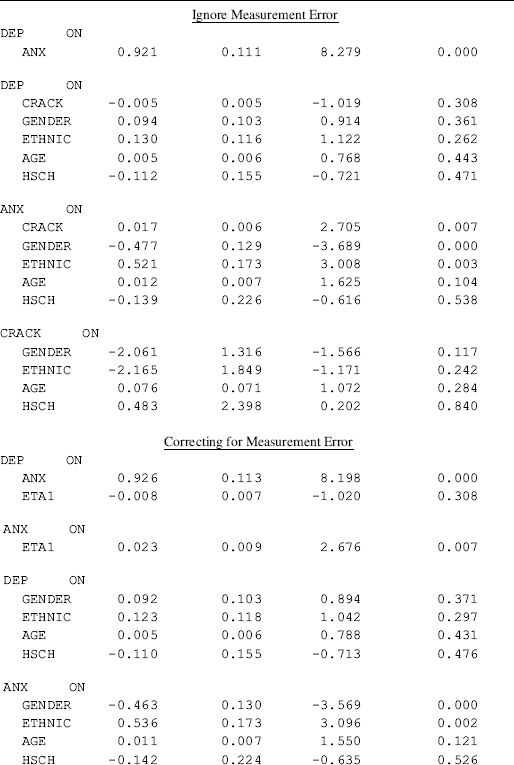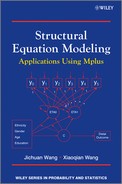3.3 Correcting for Measurement Errors in Single Indicator Variables
In Chapters 1 and 2 we have discussed that the measurement model is designed to handle measurement errors in the observed variables, and at least three indicators per factor are needed in a CFA model. In real research, observed variables are very often treated as either independent or dependent variables in a model assuming no measurement errors. In order to understand how failing to account for measurement errors in a single indicator can result in attenuated parameter estimates, the influence of measurement errors is briefly reviewed in Appendix 3.A.
When measurement errors are ignored in a regression, biased parameter estimates and standard errors can occur (Hayduk, 1987). A variety of statistical methods (both parametric and nonparametric) can be used to correct for measurement errors and to make adjustments for the relations between the flawed variables and others (Allison and Hauser, 1991; Armstrong, Whittemore, and Howe, 1989; Greenland and Kleinbaum, 1983; Marshall and Graham, 1984; Rosner, Spiegelman, and Willett, 1990; Thomas, Stram, and Dwyer 1993). When multiple indicators per latent variable are available, SEM is a powerful approach to mitigate the problems of measurement errors in understanding the relationship among variables in the model. In the case where a single indicator variable is included in a model to predict endogenous variable(s), an appropriate way to adjust for the influence of measurement error is to employ external measurement reliability for this variable.4 Once the reliability of a variable is known or approximated, its unstandardized error variance can be treated as fixed so that its measurement error will be controlled in modeling (Hayduk, 1987; Bollen, 1989a; Jöreskog and Sörbom, 1989; Munck 1991; Wang et al., 1995).
When a latent variable ![]() has only one observed indicator y, the simple measurement model is:
has only one observed indicator y, the simple measurement model is:
(3.12) ![]()
Then, the error variance ![]() , which is the variance of y unexplained by the latent variable
, which is the variance of y unexplained by the latent variable ![]() , can be described as:
, can be described as:
where ![]() is variance of the observed indicator variable y, and
is variance of the observed indicator variable y, and ![]() is the reliability of y (Appendix 2.B). To control for measurement error of a single indicator, the error variance
is the reliability of y (Appendix 2.B). To control for measurement error of a single indicator, the error variance ![]() is specified, while the factor loading
is specified, while the factor loading ![]() is usually fixed to 1.0 in the model. In the model shown in Figure 3.5, crack-cocaine use frequency is treated as a single indicator variable (Crack), its variance estimated from the sample is Var(Crack) = 85.65, and its reliability estimated from a test–retest is
is usually fixed to 1.0 in the model. In the model shown in Figure 3.5, crack-cocaine use frequency is treated as a single indicator variable (Crack), its variance estimated from the sample is Var(Crack) = 85.65, and its reliability estimated from a test–retest is ![]() . With this information, its error variance can be estimated using Equation (3.13):5
. With this information, its error variance can be estimated using Equation (3.13):5
Figure 3.5 Correcting for measurement error in a single indicator.

(3.14) ![]()
The error variance ![]() then is specified in the following Mplus program to correct for measurement error in the single observed variable Crack.
then is specified in the following Mplus program to correct for measurement error in the single observed variable Crack.
Mplus Program 3.8

where Eta1 (![]() ) is the true measure of crack-cocaine use frequency. The error variance of the observed variable Crack is fixed by the statement Crack @ 23.98 in the MODEL command.
) is the true measure of crack-cocaine use frequency. The error variance of the observed variable Crack is fixed by the statement Crack @ 23.98 in the MODEL command.
Table 3.8 provides comparisons of model results with and without correcting for measurement error in variable Crack – the observed measure of crack-cocaine use frequency. Without taking into account the measurement error, the variable Crack has no significant effect (−0.005, P = 0.308) on depression (DEP), but a significant positive effect (0.017, P = 0.007) on anxiety (ANX) (Table 3.8). After correcting for measurement errors in the variable Crack, the corresponding coefficients became: −0.008 (P = 0.308) and 0.023 (P = 0.007). The results show that the effects of crack-cocaine use frequency on depression and anxiety were attenuated by about 26–37% if its measurement error was not handled in modeling. When the reliability of the single indicator was smaller, the attenuation effects would be even larger. The effects of the covariates (i.e., Gender, Ethnic, Age, and Hsch) on Crack remain unchanged with and without correcting for measurement error in the equation of regressing Crack on the covariates. This is because Crack is the dependent variable in this equation, and its measurement error was absorbed into the residual term of the equation.
Table 3.8 Comparisons of model results with and without correcting for measurement error in single indicator.



